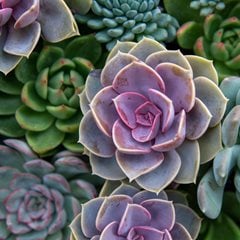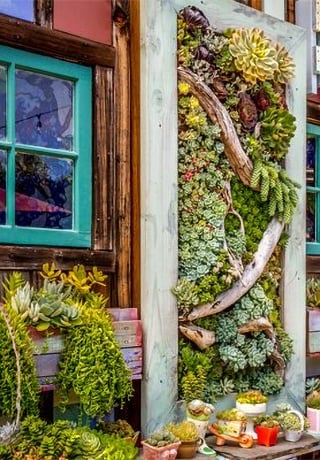A GUIDE TO GROWING ECHEVERIA
Add color to indoor and outdoor spaces with this easy-care succulent plant
Photo by: jamesptrharris / Shutterstock
With the increased popularity of succulents, more gardeners are discovering echeveria plants. This stylish plant forms symmetrical rosette shapes with fleshy leaves that come in a wide array of colors and forms. With hundreds of different varieties, this versatile plant can be grown indoors or outside, as a tabletop accent, in floral arrangements, terrariums, containers, living walls, rock gardens, garden beds, and waterwise borders.
When given the right growing conditions, echeveria is virtually carefree. Like other succulents, this drought-tolerant plant stores water in its leaves, allowing it to survive through dry spells. A member of Crassulaceae, Echeveria is closely related to other popular succulents including hen and chicks (Sempervivum). Here’s how to add these charmers to your home decor or landscape.
On this page: Basics | Growing | Care and Maintenance | Echeveria Pictures | Toubleshooting | Display Ideas | Lookalikes
- BASICS
- GROWING ECHEVERIA
- ECHEVERIA CARE AND MAINTENANCE
- ECHEVERIA VARIETIES
- TROUBLESHOOTING
- DISPLAY IDEAS
- ECHEVERIA LOOKALIKES
BASICS
Botanical name:
Echeveria spp.
Common names:
Echeveria, hen and chicks
Zones:
USDA Zones 9-11, or grown as a houseplant
Care level:
Easy to moderate
Light requirements:
Full sun; echeverias need at least 4-6 hours of bright light per day.
Growth rate:
Slow to fast, depending on the variety and growing conditions.
Foliage:
Fleshy smooth or crinkled evergreen leaves form a symmetrical rounded rosette. Spoon-like leaves have pointed tips and a protective waxy coating. Colors occur in shades of green, pink, blue, grey, purple, orange, burgundy, and bicolors.
Flowers:
Clusters of bell-shaped flowers develop on long slender stems, blooming from spring to fall. Flowers occur in sunset hues of yellow, coral, pink and orange. Blooms will be scant when grown indoors.
Habit and size:
Low mounding habit with horizontal offsets. Individual rosettes can grow 1 to 4 inches tall and 2 to 12 inches in diameter. Offsets may reach 14 to 24 inches tall, with clumps of rosettes spreading as much as 24 to 36 inches wide, depending on the variety.
ECHEVERIA GROWING TIPS

Echeveria elegans growing in rock garden. Photo by: Tim Ludwig / Millette Photomedia
Where to grow:
Indoors, place in an area that receives bright direct light, such as a south-facing window; or supplement with artificial lighting. Outdoors, place in a spot that gets at least 4 to 6 hours of direct sunlight.
Temperature and humidity:
Echeveria prefer hot, dry conditions. Cold temperatures or drafts can lead to plant damage. Too much humidity can cause root rot. Average household conditions are usually sufficient. Outdoor plants can tolerate temperatures between 35 to 95 degrees F. Ideally, 65 to 80 degrees F in spring and summer, slightly cooler in winter.
Soil type:
Plants require a porous, well-draining soil to thrive, and prefer a slightly acidic pH of 6.0. Use cactus potting mix or make your own by mixing three parts all-purpose potting soil, two parts coarse sand, and one part perlite.
Pot requirements:
Choose a pot that is ten percent wider than the diameter of the plant and slightly deeper than the root ball. Make sure containers have good drainage holes to prevent root rot.
Propagation:
Echeveria can be propagated from offsets, individual leaves, or by seed.
ECHEVERIA CARE AND MAINTENANCE
Watering:
Echeverias are drought-tolerant and prefer dry conditions. Water echeverias only after the soil has dried out completely. Avoid getting leaves wet and don’t overwater to prevent root rot. Plants will need more frequent watering during summer, every week or two depending on temperature and soil conditions. Reduce watering in winter when growth slows down.
Fertilizing:
Echeverias need very little fertilizing. Apply a slow-release all-purpose fertilizer in spring when plants are actively growing. Dilute by 2 to 4 times the regular strength and apply less often than recommended. Cease fertilizing during winter months.
Pruning:
Trim off brown, yellow or damaged leaves as needed.
Repotting:
Plants seldom need repotting, only when they outgrow their current container. Repot in spring and wait until soil is completely dry. Remove from the pot and gently brush soil from roots. Place in a new container that is 1/2 to 1 inch larger than the previous pot and use fresh soil. Water thoroughly and place in bright indirect light until plant has recovered in 2 to 3 weeks.
Pests:
Pests can include mealybugs, spider mites, aphids, scale, nematodes, or root meal bugs. Rinse off bugs with water or dab affected areas with 70% rubbing alcohol. For more severe cases, treat with a general purpose insecticide.
ECHEVERIA VARIETIES
TROUBLESHOOTING
The most common problems for echeveria are due to over- or underwatering. Here are some symptoms to look for:
- Yellow or dropped leaves can indicate overwatering or poor drainage. Reduce watering and make sure pots or beds have adequate drainage. Add perlite, gravel, or sand to the potting medium or beds to improve drainage.
- Wilted or shriveled leaves can occur with underwatering. Increase the amount of water, making sure it drains through the bottom of the pot.
- Leggy plants or weak new growth can be an indication of too little light. Move plants to a brighter area. Indoor houseplants benefit from being placed outdoors when all danger of frost is past.
- Yellowing or whitening of leaves followed by brown scabs can indicate too much sun exposure, or that plants were introduced too quickly to brighter light. Move plants to a spot that receives less light.
- Discolored mushy leaves and stems can indicate overwatering and root rot. Remove plant from pot and inspect for rot damage. Cut off rotted sections and repot in fresh soil.
- Bottom leaves that occasionally become shriveled or turn black are a sign of age and not harmful to the plant. Remove these older leaves for a tidier look.
- Abnormal, twisted, or irregular growth can indicate cresting, which is a mutation that is not harmful to plants. The growth can be removed or allowed to develop.
DISPLAY IDEAS

Photo by: Janet Loughrey
- Plant a terrarium with echeveria and other drought-tolerant succulents. Add decorative touches such as colored rocks and miniature statuary.
- Create a floral arrangement in a pedestal pot with small echeveria rosettes in different colors. Add trailing succulents such as string of pearls or donkey’s tail for an eye-catching arrangement.
- Adorn a rock garden with echeverias and other drought-tolerant succulents and alpines. Before the first frost in fall, move echeverias indoors for the winter.
- Create a living wall adorned with echeverias and other succulents for a colorful tapestry to hang along a fence. (See an example in this backyard design).
- Add a focal point in a sunny part of the yard with a bowl-shaped container elevated on a pedestal. Plant with echeverias and other succulents for a low-maintenance season-long display.
HEN AND CHICKS: ECHEVERIA OR SEMPERVIVUM?
Both share the common name of hen and chicks and look very similar. Here's how to tell them apart:
Other echeveria lookalikes include:
- Mexican ghost plant (Graptopetalum) has thicker leaves in colors of pale gold or green. Mature size is smaller, with star-shaped flowers and offsets that break off from the roots.
- Graptoveria is a hybrid cross between Graptopetalum and Echeveria.
- Aeonium is native to northern Africa and nearby islands. The rosettes are flatter, forming on elongated stems that produces offshoots. Plants die after flowering.
See more about how to grow Sempervivum.
RELATED:
Succulents & Succulent Garden Design
Succulent Care
Types of Succulents













